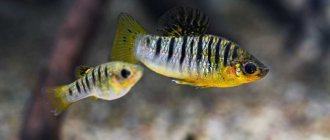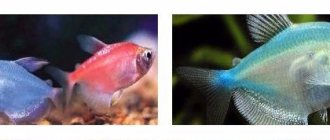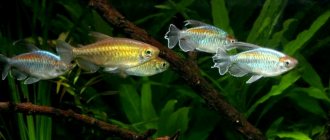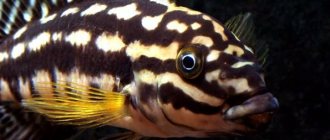Tarantula spiders, Lasiodora
Thanks to this particular tarantula spider of the genus Lasiodora , it became widely known and popular among keepers. Lasiodora parahybana, or as it is also called the Horse Spider, is considered one of the largest tarantulas: the paw span of this tarantula can reach up to 25 centimeters. Lasiodora parahybana lives in the tropical forests of eastern Brazil, where the spider stays hidden during the daylight hours, waiting for darkness to come out to hunt.
Another distinctive feature of Lasiodora parahybana (in addition to its large size) is its amazing growth rate; in just a year, under the right conditions of keeping and feeding, the spider can reach 15 centimeters in paw span.
Lasiodora parahybana is an excellent structural engineer; if provided with a sufficient layer of substrate, the spider will surprise you with constant rearrangements and changes in the landscape of the terrarium. This tarantula can be recommended to beginners due to its relatively calm nature and low toxicity of the poison.
Characteristics of Lasiodora parahybana:
Size of an adult: Lasiodora parahybana is a very large tarantula spider, the leg span reaches 18-20 (sometimes up to 25) centimeters, the body up to 8-10 centimeters.
Growth rate: Sexual maturity in Lasiodora parahybana occurs at 2-3 years in females and 1.5-2 years in males, respectively.
Lifespan: Females of this species, according to some data, can live up to 12-15 years.
Species: Lasiodora parahybana is a ground-dwelling tarantula spider.
Irritant hairs: Present, used as the first line of defense during irritation and stress.
Venom: Lasiodora parahybana does not have dangerous venom, but people with allergies to bee and wasp stings may experience complications.
Aggressiveness and danger: This species is quite calm and can be recommended for beginners, however, it is necessary to maintain safety when cleaning the terrarium and communicating with this tarantula.
The most poisonous spiders in the world
There are many poisonous arachnids. The most dangerous spider in Russia is the karakurt. He lives in the south of the country. But during abnormal heat, karakurt migrates to other regions.
The venom of the great black widow is particularly dangerous. After a bite, a person experiences unbearable pain. If a special vaccine is not administered in time, death occurs.
Other poisonous, large spiders of Russia are Heiracanthium, Mizgir, Solfuga, Bagworm, Black Fathead, Argiope. The most dangerous spiders in the world are the black widow, the Chilean recluse, the katipo, the funnel-web, the Brazilian, and the crab-backed predator.
Brazilian spider
According to the Guinness Book of Records, the most poisonous spider in the world is the Brazilian arachnid. The main food of the predator is small insects. But it can also bite rodents, birds, and amphibians.
The arthropod clearly sees silhouettes and moves quickly. When an animal attacks, it raises its front legs upward. After a bite, a person develops a severe allergy, which can only be eliminated with the help of a special vaccine.
The insect is especially dangerous for people with weakened immune systems, the elderly and children.
After a Phoneutria bite, the following symptoms occur:
- strong pain;
- dyspnea;
- weakness;
- respiratory paralysis;
- impotence in men.
The Brazilian Araneae is found in South or Central America. The animal easily gets into the pockets of clothes, houses, shoes, cars or bags. But Phoneutria attacks only in self-defense.
funnel web spider
This type of large arthropod is distributed throughout the world. But more often they live in Australia.
There are more than 500 species of funnel-web spiders. Most arachnids are not dangerous. But some of them, such as the Sydney leukopachine, can be particularly poisonous. After being bitten by a predator, a child dies immediately, and an adult dies within 15 minutes.
The name arachnids comes from the peculiar funnel weaving used in the construction of the home.
Black Widow
The bite of Latrodectus mactans is fatal to humans. Moreover, the venom of females is more toxic than that of males.
There are 31 species of black widows, but not all of them are dangerous. Many representatives of the subtype crawl into people's homes, where they lay eggs. Females are especially aggressive and can attack humans.
After a black widow bite, severe muscle cramps and paralysis occur. The venom of these predators is much more deadly than the venom released by a rattlesnake.
A characteristic sign of a black widow is spots resembling an hourglass located on the black back.
Chilean hermit
Chilean poisonous spiders live in South America. Sometimes they can be found in Indiana, Nebraska, Texas, and Iowa.
This is the biggest hermit. Arachnids are brown in color. Its legs and belly are covered with short hair. The predator has 6 pairs of eyes.
The Chilean hermit bites painfully. The insect's venom paralyzes internal organs and the nervous system. The poison also provokes hemolytic anemia, which leads to renal dysfunction.
Redback spider
One of the most beautiful, large, but also poisonous arthropods is the red-backed spider. Arachnologists know where the predator lives: the homeland of the webworm is Australia.
The venom of the redback arthropod is neurotoxic. After its bite, paralysis occurs. Without timely medical care, a person dies.
The Australian widow is distinguished by a black round belly, on which there is a red longitudinal stripe.
Large red-backed arachnids love to live in cities, which is dangerous for humans. They often hide under a canopy, in a barn or basement.
Katipo
Katipo are small, poisonous spiders. Their belly is no larger than a pea.
Latrodectus katipo is black in color. The animal has light markings on the front of its abdomen and bright red stripes along the border. At the bottom of the abdomen is a red symbol resembling an hourglass.
Katipo lives in New Zealand, hiding under logs. The poisonous spider feeds mainly on beetles.
Katipo very rarely bite and do so only for self-defense.
If its poison enters the human body, the following symptoms will appear:
- abdominal cramps;
- fever;
- pain;
- weakness;
- hyperhidrosis.
Lasiodora parahybana maintenance at home:
The terrarium for this tarantula spider should be chosen a little larger than usual; dimensions 30x40x30 (length/width/height) or a little larger are good, because the spider is quite large. In addition to the terrarium, tarantulas can be kept in plastic containers of a suitable size , the main thing is to solve the issue of ventilation.
As for the ventilation in the terrarium of Lasiodora parahybana, it, like the dimensions, is better to make it a little larger, standard. This spider loves high humidity, and in such conditions there is a high risk of mold and the like. Lasiodora parahybana is also quite inquisitive, which means it is prone to escape; it is common for a tarantula to attempt to attack the ventilation holes (it tries to gnaw through it, escape). Keep this in mind.
At the bottom of the terrarium, as with other tarantula spiders, a moisture-absorbing substrate should be placed. Coconut substrate is good , which will maintain humidity and also give the spider the opportunity to be creative. The ideal substrate thickness would be a layer of 5 centimeters, but Lasiodora parahybana can be kept on a small layer if artificial shelters are provided, such as half a coconut, bark, etc.
The optimal temperature for keeping Lasiodora parahybana in a terrarium is 24-26 degrees Celsius. Humidity can be in the range of 70-80% or slightly higher, Lasiodora parahybana is quite moisture-loving.
Lasiodora parahibana sex determination
Post by Killogram » Fri Oct 29, 2010 12:11
Re: Breeding Parahiban
Post by Bullet » Fri Oct 29, 2010 12:20
Re: Breeding Parahiban
Post by Dominion » Fri Oct 29, 2010 12:27
Even if what you do leads to the desired result, there will likely be other consequences that are completely unexpected. No less than three, and one of them will most likely turn out to be unpleasant. (c) Suan Sanchey
1%-er Spider Crew Squad
Re: Breeding Parahiban
Post by Bullet » Fri Oct 29, 2010 12:34
Re: Breeding Parahiban
Post by Killogram » Fri Oct 29, 2010 12:42 pm
Re: Breeding Parahiban
Post by Bullet » Fri Oct 29, 2010 12:48
Re: Breeding Parahiban
Post by Killogram » Fri Oct 29, 2010 12:50
Re: Breeding Parahiban
Post by Bullet » Fri Oct 29, 2010 13:19
Re: Breeding Parahiban
Post by Dominion » Fri Oct 29, 2010 2:32 pm
Even if what you do leads to the desired result, there will likely be other consequences that are completely unexpected. No less than three, and one of them will most likely turn out to be unpleasant. (c) Suan Sanchey
1%-er Spider Crew Squad
Re: Breeding Parahiban
Post by Bullet » Fri Oct 29, 2010 14:45
Re: Breeding Parahiban
Post by SSReaV » Sun Jan 02, 2011 21:54
Source
Lasiodora parahybana. Feeding:
Like other tarantula spiders, Lasiodora parahybana should be fed with food insects of a suitable size (about the size of the spider's body, excluding legs). The feeding frequency for adults is 1-2 times a week, for young animals 2-3 times. Marbled , Turkmen , Madagascar , Argentine , six-spotted or other food cockroaches, zophobas beetle larvae and other food items are well suited for feeding
The issues of feeding babies and adolescent tarantula spiders are discussed in more detail in the article: “ Feeding tarantula spiders of younger ages .”
On the Internet you can often find recommendations for feeding Lasiodora parahybana and other large spiders with frogs, mice, rats, etc., but I do not recommend doing this for the reasons outlined in the article: “ Feeding tarantula spiders .”
Lifestyle and habitat
The range of the described animals is very wide, and their widespread occurrence has made them quite famous throughout the world. The external diversity of horses depends on their habitat. Most of the species and the most interesting of them are found in the tropics.
But horses have adapted to live in a wide variety of terrestrial conditions and have populated many corners of the planet. They thrive in forests, mountains, even deserts, where they spend their lives on trees, plants, grass, rocks, soil and sand.
Such creatures are also found in temperate latitudes. Being heat-loving, they are often noticed by people at the moment when they crawl out of their hiding places and perch on the walls of buildings and other well-lit, heated places in order to heat their sides in the morning sun before starting to hunt down their prey.
Sometimes the species name can be used to judge the location of such spiders. An example of this is the hawthorn racer. Such creatures often catch the eye of a person, sitting on the tree and shrub flora mentioned in the name.
Although it is not so easy to notice them, because their color allows them to almost completely merge with their given environment. The body of the spiders itself is similar in shade to the trunks and branches, and the orange areas of the legs are in harmony with the fruits of the hawthorn. Such horses live on the Black Sea coast and in other places with a similar climate.
Tiny animals do not need the company of their own kind; they are loners. During the day, spiders are completely busy hunting, and at night they rush to hide in the cracks of rocks, trees, and buildings. This is where these eight-legged creatures tend to hide on days of bad weather, waiting for good weather and warmth.
Their bed is a cradle, independently woven from alkali spider threads. They also survive the winter in reliable shelters, from which they emerge only with the arrival of spring. These tiny spiders are incredibly brave and rarely run away at the sight of a strong opponent.
They attack and attack more often. Watching their dexterity, one cannot help but admire the supernatural abilities of these creatures. They are very mobile, run great, and the claws on their paws help them easily hold on and climb smooth vertical surfaces.
When hunting, they do not spin webs like their other eight-legged counterparts. They use their silk threads as a safety net while making dizzying jumps, the length of which exceeds their own parameters at least twenty times, or even much more.
Giant tarantula from Sri Lanka (Poecilotheria rajaei)
Leg span – up to 20 cm.
Giant tarantula from Sri Lanka (Poecilotheria rajaei)
This tarantula was first discovered in 2009, when a villager brought a dead spider to a research organization in Sri Lanka. A team of scientists was assembled to study the new species. During the expedition, they were accompanied by police officer Michael Rajakumar Purajah, after whom the spider was named.
A huge poisonous spider lives in trees. Several individuals were found on the premises of an old hospital in Mankulam.
According to Australian arachnologist Robert Raven, the tarantula discovered in Sri Lanka may be just a local variety of the already known species Poecilotheria regalis, which is found in mainland India.
Arabian cerbal (Cerbalus Aravaensis)
Leg span – up to 14 cm.
Arabian cerbal (Cerbalus Aravaensis)
Dehydration and sunstroke are not the only dangers that await travelers in the Arabian Desert on the border of Israel and Jordan. There you can find the largest huntsman spider in the Middle East. He builds a den in the sand and escapes the heat in the depths all day, and goes out hunting at night. Not very poisonous, as is believed, and not yet well studied. Like the spider Poecilotheria Rajaei, it was first discovered in 2009.
Buy with this product
Coconut crumb Simple Zoo, 650g
Stone drinking bowl for reptiles Simple Zoo
Your request has been accepted!
You will receive a notification when the product goes on sale to your contacts.
Terrarium 30*30*30 cm PetPetZone (spider)
Your request has been accepted!
You will receive a notification when the product goes on sale to your contacts.
Background for terrarium 30*30 cm PetPetZone “Oak bark”
Your request has been accepted!
You will receive a notification when the product goes on sale to your contacts.
Grape driftwood for a terrarium
Lasiodora parahibana sex determination
Moderator: notami
what to feed Lasiodora parahybana L2?
Message Your Pauchestvo » Mon Jul 07, 2014 20:57
Re: what to feed Lasiodora parahybana L2?
Post by micro » Mon Jul 07, 2014 21:07
Re: what to feed Lasiodora parahybana L2?
Post by Elen-ka » Mon Jul 07, 2014 21:13
Re: what to feed Lasiodora parahybana L2?
Message Your Pauchestvo » Mon Jul 07, 2014 21:30
Re: what to feed Lasiodora parahybana L2?
Post by Elen-ka » Mon Jul 07, 2014 22:00
Re: what to feed Lasiodora parahybana L2?
Post by micro » Mon Jul 07, 2014 22:46
Re: what to feed Lasiodora parahybana L2?
Post by Elen-ka » Mon Jul 07, 2014 23:28
Re: what to feed Lasiodora parahybana L2?
Posted by smog » Tue Jul 08, 2014 10:39
Re: what to feed Lasiodora parahybana L2?
Post by emess » Thu Jul 10, 2014 22:44
Contact us
You can send questions and suggestions to or by phone.
Why do people buy from Planet Exotics?
Imagine you want to buy yourself a turtle (or snake?). Look at different pet stores, prices, read descriptions. You delve into the content, take a closer look, shovel through mountains of information. In the end, you still choose our pet store and place an order.
We understand that shipping animals is very stressful, especially if you are purchasing an animal for the first time. Therefore, we have decided to provide a guarantee:
We treat our animals responsibly and therefore:
Source











